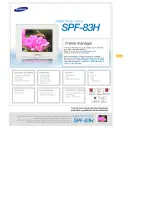
Function description
Operating Manual PSENvip RL D P Set
1001641-EN-09
| 33
The input and display field is used to
}
Display the active protected field mode
See chapter 8, "Operation"
}
Enter the overrun
See chapter 7, "Commissioning"
}
Menu Selection
}
Display the adjustment image during initial commissioning
See chapter 7, "Commissioning"
}
Display the adjustment image during a tool change
See chapter 7, "Commissioning"
}
Display of error messages and system data
See Chapter 9, "Diagnostics and Troubleshooting"
4.4.4
Communication with the safety system
Communication between the PSENvip and safety system is required if you use tools that
cannot be safeguarded in compliance with the standards (see section entitled "Tool
shapes", under "Safety"). This is the case with tool classes 2 and 3. User programs that do
not support communication with the PSENvip can be used if you only intend to safeguard
tools of tool class 1. This is the case with older versions of the PSENvip, for example.
Communication between the PSENvip and the PLC safety system is conducted via digital
inputs and outputs. Some inputs and outputs on the PSENvip have another function com-
pared to normal mode.
Communication only occurs in the system status TEST. This status is adopted
}
After power-up.
}
After a tool change.
}
After a 0/1 pulse edge at the input System-Init.
}
Periodically every 2 minutes.
X1, 1
PLC Ready
X2, 1
X1, 6
X2, 6
X2, 2
PSENvip
Tool class PLC -> PSENvip Bit 1
Acknowledge PSENvip -> PLC
Tool class PSENvip -> PLC Bit 1
X1, 3
X1, 4
Activate
Tool class PSENvip -> PLC Bit 2
Tool class PLC -> PSENvip Bit 2
PLC
I1
I4
I3
I2
O3
O2
O1
Fig.: Digital inputs and outputs for communication
















































